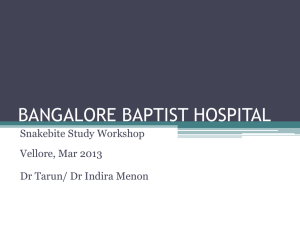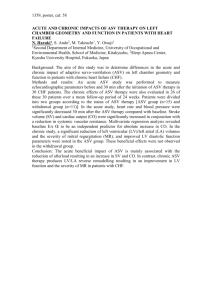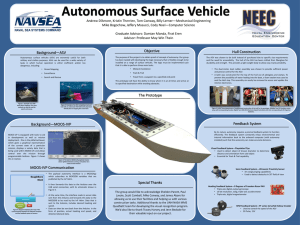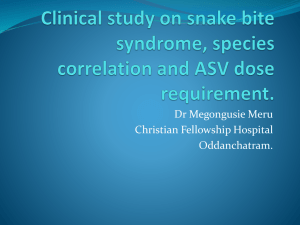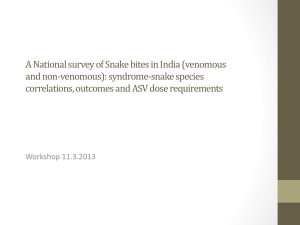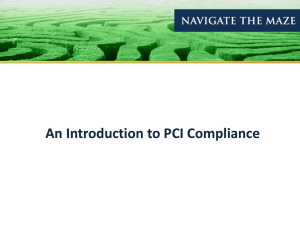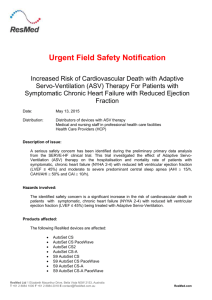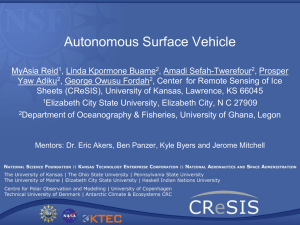J K J
advertisement
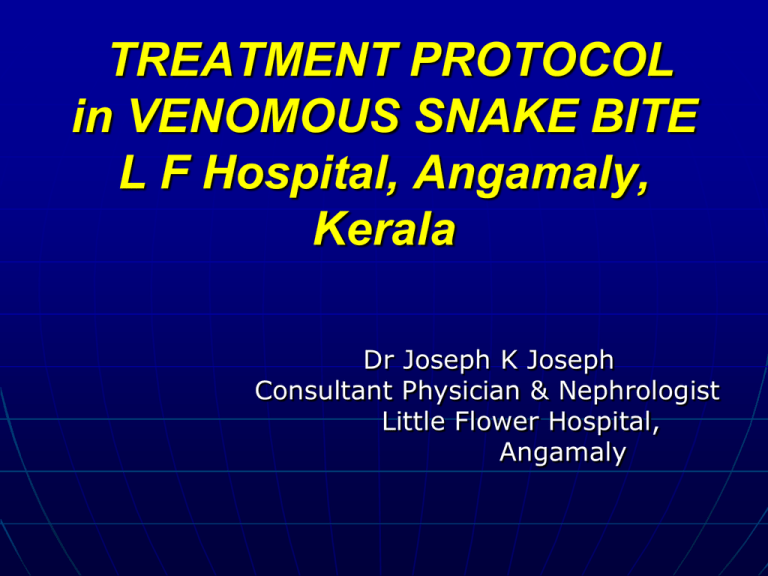
TREATMENT PROTOCOL in VENOMOUS SNAKE BITE L F Hospital, Angamaly, Kerala Dr Joseph K Joseph Consultant Physician & Nephrologist Little Flower Hospital, Angamaly SNAKEBITE TREATMENT PROTOCOL PROTOCOL FOR DIAGNOSIS TREATMENT PROTOCOL Hemostatic & clinical markers suggesting envenomation I. Deranged haemostatic profile, suggested by either or all of -An abnormal WBCT - PT above 1.5 times normal and a APTT showing 6 secs above control 11 a. The presence of significant local inflammation Tender enlarged lymph nodes Recurrent nausea,vomiting and abdominal pain Acute abdominal tenderness Bleeding manifestations 111. BLOOD PARAMETRES a) Crenated RBC in peripheral blood smear b) Rise in serum creatinineof >30% of base line value c )Proteinuria>2+ d)Raised D dimer value e )Low platelet value<100000/mm3 Snake identification charts Examination of the bitten part: Fang marks The extent of swelling Palpate lymph nodes draining the limb Limb girth General examination Measure the blood pressure (sitting up and lying to detect a postural drop indicative of hypovolaemia) and heart rate. Examine the skin and mucous membranes for evidence of petechiae, purpura, discoid haemorrhages, ecchymoses and, in the conjunctivae, for haemorrhages and chemosis. Thoroughly examine the gingival sulci, using a torch and tongue depressor, as these may show the earliest evidence of spontaneous systemic bleeding. Examine the nose for epistaxis. TREATMENT PROTOCOL Managing pain Handling Tourniquets Anti snake Venom- dosage, administration, side effects, managing anaphylaxis Treating complications Managing Pain Causes severe pain at bite site Pain Killers-Paracetamol 5001000mg 6 hrly orally in adults, Pediatric dose- 10 mg /kg 4-6 hrly orally Severe pain-Tramadol 50 mg orally Tramadol IV if needed No NSAID HANDLING TOURNIQUETS Recommendation- No tourniquet to be applied Current practice- see many victims reaching with tourniquets Do not suddenly remove the tourniquet Sudden removal-massive surge of venom causing neurological paralysis and hypotension due to vasodilatation Indications Local envenoming: Local swelling involving more than half of the bitten limb (in the absence of a tourniquet) Swelling after bites on the digits (toes and especially fingers) Rapid extension of swelling (for example beyond the wrist or ankle within a few hours of bites on the hands/ feet) Development of enlarged tender lymph nodes draining the bitten limb Close Observation Patients should be observed for a period of at least 24 hours • Krait & Humpnosed pit viper – delayed envenoming (612hrs) Monitor • Neurotoxic signs • 20 min WBCT WBCT-½hrly – 3 hrs hrly - 3 hrs 2hrly – 6 hrs 4hrly 12hrs 20WBCT (20 minutes Whole Blood Clotting Test) Place a few ml of freshly sampled venous blood in a new, clean, dry, small glass test tube vessel Leave undisturbed for 20 min at ambient temperature Tip the vessel once If the blood is still liquid (unclotted) and runs out, the patient has hypofibrinogenaemia (incoagulable blood) as a result of venom induced consumption coagulopathy If the vessel used for the test is not made of ordinary glass, or if it has been cleaned with detergent, its wall may not stimulate clotting ofthe blood sample (surface activation of factor XI – Hageman factor)and test will be invalid Other Tests Hematological- Hb, PCV, TLC, DLC, Peripheral Smear,Platelet count –repeated 6 hourly for the first 24 hours in viperidae bites C T, B T , P T, APTT DIC Workup- D-dimer,FDP,Fibrinogen, Repeated on the third day Renal function tests- Liver function tests- AST, ALT,Bilirubin, Total protein and albumin Muscle enzymes,Blood sugar Other Tests Urine – myoglobin, Hemoglobin and protein Blood group Oxygen saturation ABG Tests repeated on daily basis- Hb, PCV, creatinine, platelets, and urine protein If possible, intracompartmental pressure should be measured Blood flow and patency of arteries and veins assessed (e.g. by doppler ultrasound). Measuring intracompartmental pressure at LFH Ventilatory capacity Use a peak flow meter Spirometer (FEV1 and FVC) Initial management ► ► ► ► ► ► ► ► Tetanus toxoid Antibiotics Pain relief Hydration –IV Fluids Monitor Intake-Output Respiratory rate Mark the extent of local swelling Measure the swollen limb HAEMATOTOXIC ENVENOMATION Russel viper injects on an average 63 mg of venom[5 to 147mg] 1ml ASV neutralise 0.6 mg of russel viper venom 1 vial-10 ml=6mg ASV Total required dose wil be between 100ml[10 vial] to 250 ml[25 vial] So starting with 10 vials ensures sufficient neutralising power Recommended Dose of ASV Haemotoxic Envenomation: Treat the patient with Anti Snake Venom(ASV) Start IV Normal Saline with wide bore needle Begin with 10 vials of ASV in 100ml of NS and to start with 10-15 drops per minute for 15 minutes & watch for reactions. If the patient is not having signs and symptoms of anaphylactic shock continue the ASV drip in one hour period. Continue to monitor the vital signs at five minutes interval for first 30 minutes and then at 15 minutes interval for two hours NEUROTOXIC ENVENOMATIONNEOSTIGMINE TEST 1.5 TO 2 mg NEOSTIGMINE IV +0.6mg ATROPINE iv IN AN ADULT&0.04mg/kg NEOSTIGMINE IV+0.05mg/kg ATROPINE IN CHILDREN OBSERVE CLOSELY FOR 1 hr TO DECIDE THE EFFECT NEOSTIGMINE TEST OBJECTIVE METHODS Single breath count, mmof iris uncovered [amount covered by descending eyelid] Inter incisor distance [distance between upper and lower incisors] Length of time upward gaze can be maintained FEV1 or FVC[ if available ] Recommended Dose of ASV Neurotoxic Envenomation: Treat the patient with Antisnake venom (ASV) with the same dose for Haemotoxic Envenomation plus If Neostigmine test is +ve 0 .5 mg neostigmine at half hourly intervals for 5 injections followed by repeating the same dose at increasing intervals of 212 hrs. Each dose of neostigmine is preceeded by Inj. Atropine 0.6 mg as iv Neostigmine is not useful in Krait bite REPEAT DOSE IN HEAMATOTOXIC ENVENOMATION Initial blood test reveals coagulation abnormality – 10 vials of ASV No additional ASV untill next 6 hrs [liver unable to replace clotting factors in under 6 hrs] After 6 hrs another 20 WBCT In continued coagulation disturbance another 8-10 vials of ASV in 1 hr time Rpt CT &Rpt ASV 6 hrly until coagulation is restored. Repeat Dose- Neurotoxic For Neurotoxic Envenomation: Initial dose 10 vials given and if symptoms persist or worsen / respiratory failure, rpt 10 vials after 1-2 hours as second dose and discontinue ASV 20 vials is the maximum dose of ASV If the patient is in respiratory failure & has already received 20 vials & is on ventilator ASV therapy is to be stopped. ASV in special situations 1. 2. 3. 4. 5. Victims requiring life saving surgery. Victims who arrive late Repeat snake bites Snake bite in pregnancy and lactating women Victims having other co morbid conditions – Autoimmune disorders, debilitating status, endocrine disorders, immuno supressed status, HIV AIDS, cancer, asthma and allergy disorders, etc., Treatment of Hypotension Maintain C V P at 8cm of water Maintain urine output at >30ml/hr Normal saline if no renal failure If Hb & PCV decreased [PCV<40] FRESH BLOOD TRANSFUSION If Hb & PCV increased, [PCV>50] PLASMA EXPANDERS-FFP, Cryst- colloid Evidence of DIC [Plat<50,000]FFP, Platelet transfusion If Hypotension persists- DOPAMINE SURGICAL INTERVENTION Faciotomy - ICP>40mm Clinical features-pain on passive stretching,pain out of proportion, absence of pulse,pallor, paraesthesia, paralysis OBJECTIVE MEASUREMENT- saline manometers, STRYKER, Intracompartmental pressure monitoring equipment Management of Allergic Reactions If signs and symptoms of anaphylactic shock develop, Stop the ASV drip temporarily and treat the shock with: Inj Hydrocortisone 100 mg IV or Inj.Phenaramine maleate 2ml IV Inj,Adrenaline 1:1000 (0.5 ml)IM Oxygen administration IV.Normal saline as life line As soon as the patient recovers, restart ASV infusion slowly with careful monitoring Continue to monitor the vital signs at five minutes interval for first 30 minutes and then at 15 minutes interval for two hours Stabilise the patient and refer to the higher institution – if needed Treatment of early anaphylactic and pyrogenic reactions Adrenaline should be kept loaded Stop the ASV temporarily Give adrenaline at the first sign of a reaction 0.5mg IM in adults 0.01mg/kg IM in children Repeat every 5 to 10 mins Immediate Management Airway and Breathing Oxygenate with mask Intubate and ventilate if necessary Early anaphylactic reactions Dry cough Fever Nausea, vomiting, diarrhea Abdominal colic and cramps Rhinorrhea Conjunctivitis Lightheadedness Adrenaline Infusion Add 1 mg adrenaline to 500 ml of 5 % Dextrose (2 µg/ml). Infuse at 1ml / min. Titrate upwards to 4 ml/min. 2 to 8 ug/min Can cause life threatening arrhythmias Cardiac monitoring Treatment of Hypotension Crystalloids NS bolus 1-2L (10 to 20ml/kg in children) SECOND- LINE THERAPY Corticosteroids Hydrocortisone 200 – 500mg IV (5-10mg/kg in children) Methylprednisolone 125mg IV (2mg/kg in children) Prevents recurrent anaphylaxis For allergic bronchospasm Nebulization Salbutamol+ipratopi um bromide Nebulised adrenaline if required Additional Treatment H1 antihistamine, 10mg chlorpheniramine maleate IV, (0.2mg/kg children) or 22.5mg pheniramine maleate IV or 25mg promethazine HCl IV H2 antihistamines, Ranitidine 50mg IV When to restart the ASV after a reaction Once the patient has stabilized Once the BP is under control Once the manifestations of the reaction have subsided In severe reactions ASV can be restarted under cover of an adrenaline infusion Rate of ASV infusion can be decreased initially Patient should be under strict monitoring CONCLUSION There is need to maintain standard regimens National snake bite trt protocol is an attempt to bring about uniformity in diagnosis and management. Awareness among community about the proper first aid& early treatment Better knowledge of ASV, its complications and treatment of complications Thank you Little Flower Hospital & Research centre, Angamaly
